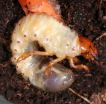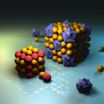(Press-News.org) Apart from the common European cockchafer (Melolontha melolontha), the European forest cockchafer (Melolontha hippocastani) is the most common species of the Melolontha genus. These insects can damage huge areas of broadleaf trees and conifers in woodlands and on heaths. Cockchafers house microbes in their guts that help them to digest their woody food, such as lignocelluloses and xylans. Scientists of the Max Planck Institute for Chemical Ecology in Jena, Germany, have now performed comprehensive RNA analyses and identified the microbiota of cockchafer larvae feeding on roots and of the adult beetles feeding on leaves. Surprisingly, the guts of adult beetles house the same microbial species that were present in the larval midgut − despite having metamorphosized from larva to beetle. These microbes include clostridia as well as other bacterial species that are as yet unknown. Moreover, only a small percentage of the microbes living in the gut originated from the roots or leaves the larvae or beetles were feeding on. These microbes seem to be characteristic bacterial symbionts with which the forest cockchafer has long been associated. (PLoS ONE, December 10, 2012; doi:10.1371/journal.pone.0051557)
Metamorphosis is a fascinating process: A caterpillar or larva, feeding on roots below-ground or leaves above-ground (depending on the species), turns into a butterfly or a beetle after pupation and quiescence. The cylindrical bodies of larvae are quite unspectacular in comparison to the colorful and delicate butterflies. It is usually the larvae that cause the most damage and threaten agricultural and silvicultural yields by feeding on plants. Among these herbivores is the European forest cockchafer (Melolontha hippocastani), a major pest of trees.
During the pupal stage the insects stop feeding completely. A fundamental transformation starts, a radical internal conversion that changes every single larval organ. The tissue and organs of the larva are converted into the new organs of the beetle. Yet the metamorphosis of some insect species is still not completely understood. What happens to the gut microbes that are needed for digesting plant tissues and therefore important for the insect's survival as soon as the larva is transformed? Are there any bacteria present in the gut of the new beetle and if so, which?
PhD candidate Erika Arias-Cordero from Costa Rica addressed these questions. Thanks to modern and sensitive detection methods, she was able to get an overview of the microbial species present in the guts of larvae and adult beetles. In so-called culture-independent studies, more than 300 individual RNA sequence segments were identified that were assigned to the different taxa of known classes of microbes. Sequences of bacterial ribosomal RNA (16S rRNA) were determined that could be distinguished from insect RNA (18S rRNA). "Using this method, we could be pretty sure we had identified all classes of microbes present in the gut. A typical microbiological approach, for which bacteria from the gut would have to be cultivated first, cannot guarantee this, because we do not know the culture media, especially for microbial species we do not know yet," says the scientist.
A total of nine different classes of bacteria were found in the cockchafer gut: Betaproteobacteria, Deltaproteobacteria, Gammaproteobacteria, actinobacteria, bacilli, clostridia, erysipelotrichi, negativicutes and sphingobacteria. Some are able to digest lignocelluloses and xylans, typical wood components. Interestingly, many classes of bacteria that were identified in the larval midgut were also found − after metamorphosis − in the gut of the adult cockchafer, even though the larval gut completely empties during the pupal stage. Moreover, Arias-Cordero found that the gut microbiome of the larvae overlaps only minimally with the microbiome of soil and root material. In other words, most microbes present in the larvae and beetles do not originate from the digested food. "This means that the forest cockchafer per se, that is, the larva hatching from the egg, e.g. via secretions passed from the mother, already has a basic set of bacterial symbionts which this insect species has co-evolved with over thousands of years," explains Wilhelm Boland, director at the institute.
This result confirms again the assumption that all higher organisms, such as plants, insects and animals (including humans), are equipped with microbial symbionts. Without these beneficial microbes, we could not live and survive; they must be classified as an integral part of our body.
Larvae and beetles, as well as soil, root and leaf samples, were collected in forests near Mannheim and Iffezheim. The Forstliche Versuchs- und Forschungsanstalt Baden-Württemberg (Forest Research Center) in Freiburg and the Fritz Lipmann Institute in Jena were also involved in this research project. [JWK/AO]
INFORMATION:
Original Publication:
Arias-Cordero E, Ping L, Reichwald K, Delb H, Platzer M, Boland, W. (2012) Comparative evaluation of the gut microbiota associated with the below- and above-ground life stages (larvae and beetles) of the forest cockchafer, Melolontha hippocastani. PLoS ONE 7(12): e51557. DOI:10.1371/journal.pone.0051557
http://dx.doi.org/10.1371/journal.pone.0051557
Further Information:
Prof. Dr. Wilhelm Boland, MPI chemische Ökologie, boland@ice.mpg.de,
+49 (0)3641 57-1200
Picture and Movie Requests:
Angela Overmeyer M.A., +49 3641 57-2110, overmeyer@ice.mpg.de
or Download via www.ice.mpg.de/ext/735.html
Not without my microbes
After metamorphosis European forest cockchafers benefit from the same bacterial symbionts housed during their larval stage
2012-12-19
ELSE PRESS RELEASES FROM THIS DATE:
Scale-up of a temporary bioartificial liver support system described in BioResearch Open Access
2012-12-19
New Rochelle, NY, December 19, 2012—Acute liver failure is usually fatal without a liver transplant, but the liver can regenerate and recover if given time to heal. A bioartificial liver machine that can provide temporary support while organ regeneration takes place has been scaled up for testing in a large animal model and is described in an article in BioResearch Open Access, a bimonthly peer-reviewed open access journal from Mary Ann Liebert, Inc., publishers. The article is available on the BioResearch Open Access website .
A team of researchers from University College ...
When the ice melts, the Earth spews fire
2012-12-19
In 1991, it was a disaster for the villages nearby the erupting Philippine volcano Pinatubo. But the effects were felt even as far away as Europe. The volcano threw up many tons of ash and other particles into the atmosphere causing less sunlight than usual to reach the Earth's surface. For the first few years after the eruption, global temperatures dropped by half a degree. In general, volcanic eruptions can have a strong short-term impact on climate. Conversely, the idea that climate may also affect volcanic eruptions on a global scale and over long periods of time is ...
Paper waste used to make bricks
2012-12-19
Researchers at the University of Jaen (Spain) have mixed waste from the paper industry with ceramic material used in the construction industry. The result is a brick that has low thermal conductivity meaning it acts as a good insulator. However, its mechanical resistance still requires improvement.
"The use of paper industry waste could bring about economic and environmental benefits as it means that material considered as waste can be reused as raw material." – This is one of the conclusions of the study developed by researchers at the Upper Polytechnic School of Linares ...
New dynamic dual-core optical fiber enhances data routes on information superhighway
2012-12-19
Optical fibers –the backbone of the Internet–carry movies, messages, and music at the speed of light. But for all their efficiency, these ultrathin strands of pristine glass must connect to sluggish signal switches, routers, and buffers in order to transmit data. Hoping to do away with these information speed bumps, researchers have developed a new, dual-core optical fiber that can perform the same functions just by applying a miniscule amount of mechanical pressure.
These new nanomechanical fibers, which have their light-carrying cores suspended less than 1 micrometer ...
Cholesterol helps regulate key signaling proteins in the cell
2012-12-19
Cholesterol plays a key role in regulating proteins involved in cell signaling and may be important to many other cell processes, an international team of researchers has found.
The results of their study are reported in the journal Nature Communications.
Cholesterol's role in heart disease has given it a bad reputation. But inside the thin membrane of a cell, the tight regulation of cholesterol at high levels (30 to 40 percent) suggests that it plays an important role in cellular processes, says Wonhwa Cho, professor of chemistry at the University of Illinois at Chicago ...
Synthetic and biological nanoparticles combined to produce new metamaterials
2012-12-19
Scientists from Aalto University, Finland, have succeeded in organising virus particles, protein cages and nanoparticles into crystalline materials. These nanomaterials studied by the Finnish research group are important for applications in sensing, optics, electronics and drug delivery.
Layer structures, or superlattices, of crystalline nanoparticles have been extensively studied in recent years. The research develops hierarchically structured nanomaterials with tuneable optical, magnetic, electronic and catalytic properties.
Such biohybrid superlattices of nanoparticles ...
Community togetherness plays vital role in coping with tragedies
2012-12-19
Community solidarity and support have remarkable benefits for people coping with traumatic mass shootings, according to an American-Finnish research study recently published by the University of Turku.
James Hawdon and John Ryan, both professors of sociology at Virginia Tech, with Finnish researchers Atte Oksanen and Pekka Räsänen, investigated the responses of four communities that suffered from similar tragedies in the United States and Finland.
People in all four communities expressed their need for belonging after the shootings, and this solidarity appeared to ...
Johns Hopkins malpractice study: Surgical 'never events' occur at least 4,000 times per year
2012-12-19
After a cautious and rigorous analysis of national malpractice claims, Johns Hopkins patient safety researchers estimate that a surgeon in the United States leaves a foreign object such as a sponge or a towel inside a patient's body after an operation 39 times a week, performs the wrong procedure on a patient 20 times a week and operates on the wrong body site 20 times a week.
The researchers, reporting online in the journal Surgery, say they estimate that 80,000 of these so-called "never events" occurred in American hospitals between 1990 and 2010 — and believe their ...
Helping the nose know
2012-12-19
More than a century after it was first identified, Harvard scientists are shedding new light on a little-understood neural feedback mechanism that may play a key role in how the olfactory system works in the brain.
As described in a December 19 paper in Neuron by Venkatesh Murthy, Professor of Molecular and Cellular Biology, researchers have, for the first time, described how that feedback mechanism works by identifying where the signals go, and which type of neurons receive them. Three scientists from the Murthy lab were involved in the work: Foivos Markopoulos, Dan ...
Men with fibromyalgia often go undiagnosed, Mayo Clinic study suggests
2012-12-19
ROCHESTER, Minn. -- Fibromyalgia is a complex illness to diagnose and to treat. There is not yet a diagnostic test to establish that someone has it, there is no cure and many fibromyalgia symptoms -- pain, fatigue, problems sleeping and memory and mood issues -- can overlap with or get mistaken for other conditions. A new Mayo Clinic study suggests that many people who have fibromyalgia, especially men, are going undiagnosed. The findings appear in the online edition of the journal Arthritis Care & Research.
More research is needed, particularly on why men who reported ...
LAST 30 PRESS RELEASES:
Automatic label checking: The missing step in making reliable medical AI
Low daily alcohol intake linked to 50% heightened mouth cancer risk in India
American Meteorological Society announces Rick Spinrad as 2026 President-Elect
Biomass-based carbon capture spotlighted in newly released global climate webinar recording
Illuminating invisible nano pollutants: advanced bioimaging tracks the full journey of emerging nanoscale contaminants in living systems
How does age affect recovery from spinal cord injury?
Novel AI tool offers prognosis for patients with head and neck cancer
Fathers’ microplastic exposure tied to their children’s metabolic problems
Research validates laboratory model for studying high-grade serous ovarian cancer
SIR 2026 delivers transformative breakthroughs in minimally invasive medicine to improve patient care
Stem Cell Reports most downloaded papers of 2025 highlight the breadth and impact of stem cell research
Oxford-led study estimates NHS spends around 3% of its primary and secondary care budget on the health impacts of heat and cold in England
A researcher’s long quest leads to a smart composite breakthrough
Urban wild bees act as “microbial sensors” of city health.
New study finds where you live affects recovery after a hip fracture
Forecasting the impact of fully automated vehicle adoption on US road traffic injuries
Alcohol-related hospitalizations from 2016 to 2022
Semaglutide and hospitalizations in patients with obesity and established cardiovascular disease
Researchers ‘listen in’ to embryo-mother interactions during implantation using a culture system replicating the womb lining
How changing your diet could help save the world
How to make AI truly scalable and reliable for real-time traffic assignment?
Beyond fragmented markets: A new framework for efficient and stable ride-pooling
Can shape priors make road perception more reliable for autonomous driving?
AI tracks nearly 100 years of aging research, revealing key trends and gaps
Innovative techniques enable Italy’s first imaging of individual trapped atoms
KIER successfully develops Korea-made “calibration thermoelectric module” for measuring thermoelectric device performance
Diversifying US Midwest farming for stability and resilience
Emphasizing immigrants’ deservingness shifts attitudes
Japanese eels, climate change, and river temperature
Pusan National University researchers discover faster, smarter heat treatment for lightweight magnesium metals
[Press-News.org] Not without my microbesAfter metamorphosis European forest cockchafers benefit from the same bacterial symbionts housed during their larval stage




